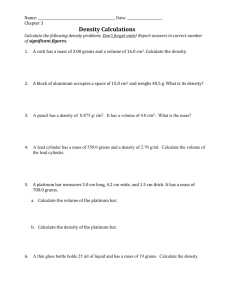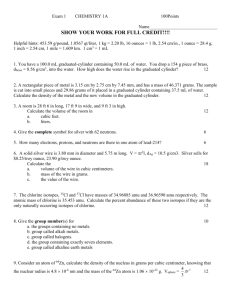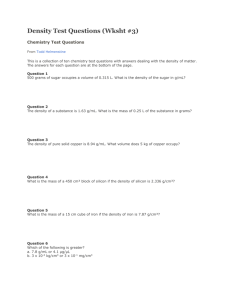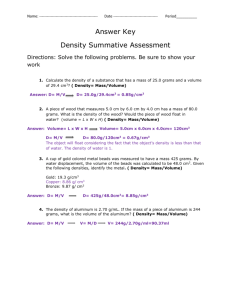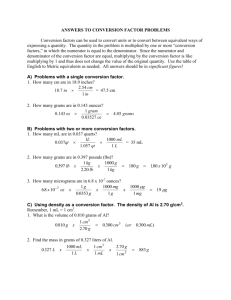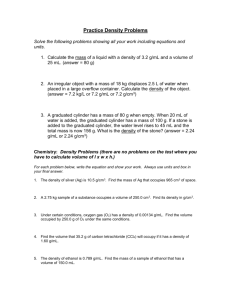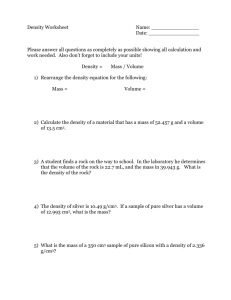Chapters 1 to 3 Review.answers
advertisement
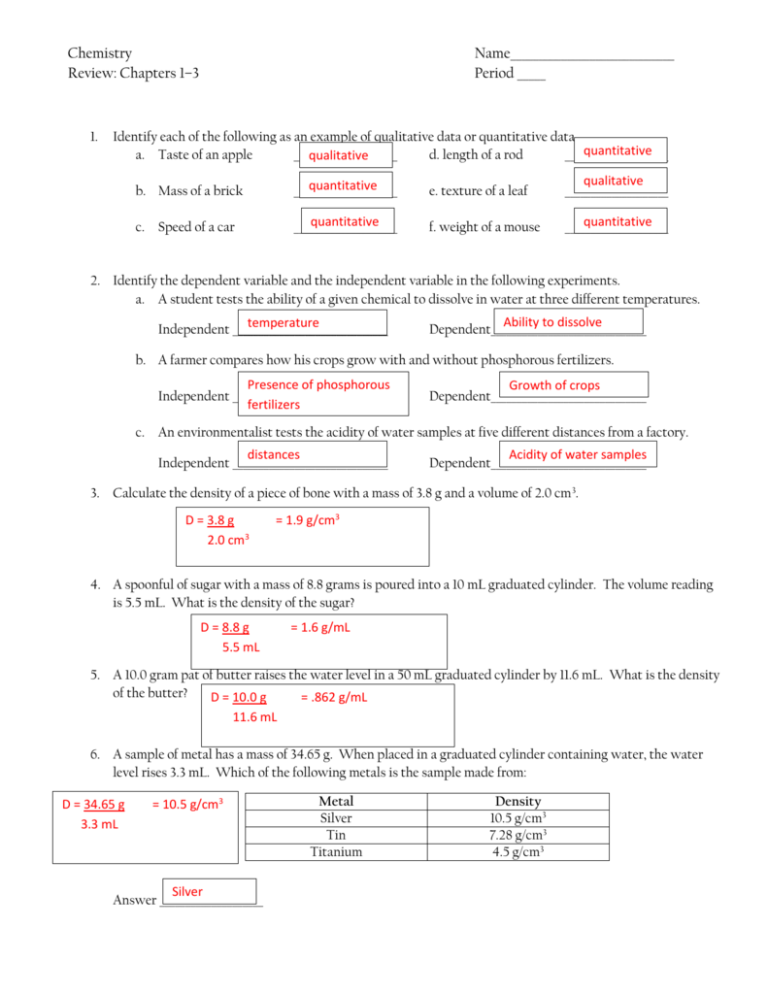
Chemistry Review: Chapters 1–3 1. Name_____________________________ Period _____ Identify each of the following as an example of qualitative data or quantitative data. quantitative a. Taste of an apple ____________________ d. length of a rod ____________________ qualitative b. Mass of a brick quantitative ____________________ e. texture of a leaf qualitative ____________________ c. Speed of a car quantitative ____________________ f. weight of a mouse quantitative ____________________ 2. Identify the dependent variable and the independent variable in the following experiments. a. A student tests the ability of a given chemical to dissolve in water at three different temperatures. temperature Independent ______________________________ Ability to dissolve Dependent______________________________ b. A farmer compares how his crops grow with and without phosphorous fertilizers. Presence of phosphorous Independent ______________________________ fertilizers Growth of crops Dependent______________________________ c. An environmentalist tests the acidity of water samples at five different distances from a factory. distances Independent ______________________________ Acidity of water samples Dependent______________________________ 3. Calculate the density of a piece of bone with a mass of 3.8 g and a volume of 2.0 cm 3. D = 3.8 g 2.0 cm3 = 1.9 g/cm3 4. A spoonful of sugar with a mass of 8.8 grams is poured into a 10 mL graduated cylinder. The volume reading is 5.5 mL. What is the density of the sugar? D = 8.8 g 5.5 mL = 1.6 g/mL 5. A 10.0 gram pat of butter raises the water level in a 50 mL graduated cylinder by 11.6 mL. What is the density of the butter? D = 10.0 g = .862 g/mL 11.6 mL 6. A sample of metal has a mass of 34.65 g. When placed in a graduated cylinder containing water, the water level rises 3.3 mL. Which of the following metals is the sample made from: D = 34.65 g 3.3 mL = 10.5 g/cm3 Silver Answer ____________________ Metal Silver Tin Titanium Density 10.5 g/cm3 7.28 g/cm3 4.5 g/cm3 7. Rock salt has a density of 2.18 g/cm3. What would the volume be of a 4.8 g sample of rock salt? D = 4.8 g = 2.2 cm3 3 2.18 g/cm 8. A piece of lead displaces 1.5 mL of water in a graduated cylinder. Lead has a density of 11.34 g/cm 3. What is the mass of the piece of lead? M=DxV (11.34)x(1.5) = 17.01 grams 9. Suppose you calculate your semester grade in chemistry as 90.1, but you receive a grade of 89.4. What is your percent error? 89.4 – 90.1 x 100 = .777% 90.1 10. On a bathroom scale, a person always weighs 2.5 pounds less than on the scale at the doctor’s office. What is the percent error of the bathroom scale if the person’s actual weight is 125 pounds? 125 – 2.5 = 122.5 122.5 – 125 x 100 = 2% 125 11. A length of wood has a labeled length value of 2.50 meters. You measure its length three times. Each time you get the same value: 2.35 meters. a. What is the percent error of your measurements? 2.35 – 2.50 2.50 b. Are your measurements precise? Are they accurate? = 6.00% Yes; no 12. Determine the number of significant figures in each measurement. 4 a. 0.000010 L ________ d. 3,001,000,000 g ________ 2 b. 40030 kg 4 ________ e. 0.002849 kg 4 ________ c. 907.0 km 4 ________ f. 2.4050 x 10–4 kg 5 ________ 13. Complete the following calculations. Record your answer in the correct number of significant figures. 439 g a. 52.6 g + 309.1 g + 77.214 g = ____________________ 695.91 mL b. 927.37 mL – 231.458 mL = ____________________ c. 245.01 km x 2.1 km = 510 km2 ____________________ d. 529.31 m ÷ 0.9000 s = 588.1 m/s ____________________ 14. Identify each of the following as an example of a physical property or a chemical property. a. Silver tarnishes when it comes in contact with hydrogen sulfide chemical ____________________ b. A sheet of copper can be pounded into a bowl physical ____________________ c. Barium melts at 725°C physical ____________________ d. Helium does not react with any other element e. A bar of lead is more easily bent than is a bar of aluminum of the same size f. Potassium metal is kept submerged in oil to prevent contact with oxygen or water g. Diamond dust can be used to cut or grind most other materials h. Rocks containing carbonates can be identified because they fizz when hydrochloric acid is applied chemical ____________________ physical ____________________ chemical ____________________ physical ____________________ chemical ____________________ 15. Identify each of the following as a property of a solid, liquid, or gas. Some answers will include more than one state of matter. Liquid/gas a. Flows and takes the shape of its container ____________________ b. Compressible gas ____________________ c. Made of particles held in a specific arrangement solid ____________________ d. Has a definite volume Solid/liquid ____________________ e. Always occupies the entire space of its container gas ____________________ f. Liquid ____________________ Has a definite volume but flows 16. Identify each of the following as an example of a chemical change or a physical change. a. Moisture in the air forms beads of water on a cold windowpane b. An electric current changes water into hydrogen and oxygen c. Yeast cells in bread dough make carbon dioxide and ethanol from sugar d. Olive oil, vinegar, salt, and pepper are shaken together to make salad dressing e. Molten bronze is poured into a mold and solidifies to form a figurine f. A reactant decomposes to form two products physical ____________________ chemical ____________________ chemical ____________________ physical ____________________ physical ____________________ chemical ____________________ 17. Identify each of the following as an example of a homogeneous mixture or a heterogeneous mixture. a. 70% isopropyl rubbing alcohol homogeneous ____________________ b. A pile of rusty iron filings heterogeneous ____________________ c. Concrete heterogeneous ____________________ d. Saltwater homogeneous ____________________ e. Gasoline homogeneous ____________________ f. heterogeneous ____________________ Bread 18. Identify each of the following as an example of an element or a compound. a. Sucrose (table sugar) compound ____________________ b. The helium in a balloon element ____________________ c. Baking soda compound ____________________ d. A diamond element ____________________ e. Aluminum foil element ____________________ f. element ____________________ The substances listed on the periodic table g. Calcium chloride pellets used to melt ice compound ____________________ 19. If 50 grams of sodium reacts with chlorine to form 126 grams of salt, how many grams of chlorine reacted? Na + Cl NaCl 50 + x = 126 x = 76 g chlorine 20. Twenty grams of aluminum reacts with 200 grams of bromide to form aluminum bromide. No aluminum is left after the reaction, but 23 grams of bromine remain unreacted. How many grams of aluminum bromide were formed? Al + Br AlBr 20 + (200-23) = x x = 197 g aluminum bromide 21. A 425 gram sample of an unknown substance contains 43 grams of carbon. What is the percent composition by mass of carbon in the substance? 43 g x 100 = 10.1 g carbon 425 g 22. Sodium has an atomic mass of 23 amu’s, and chlorine has an atomic mass of 35 amu’s. In the compound NaCl, what is the percent composition by mass of sodium? Na + Cl NaCl 23 + 35 = x x = 58 amu Na: 23 x 100 = 39.655 g Sodium 58 Cl: 35 x 100 = 60.3458 g Chlorine 58

